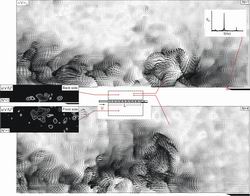You are here
Home ›Self-Sustained Oscillations due to Turbulent Shear Flow Past a Perforated Plate
Self-Sustained Oscillations due to Turbulent Shear Flow Past a Perforated Plate. A fully-turbulent boundary layer along a perforated plate can give rise to highly-coherent, self-sustained oscillations. The main images of the this layout are patterns of phase-averaged velocity at two representative instants during the oscillation cycle, designated as the N = 1 and N = 4 frames. The fields of view corresponding to these images are indicated by the rectangular (dashed line) boxes in the inset. Also indicated in the inset are patterns of instantaneous Reynolds stress correlation u′v′/U2 on the backside and frontside of the plate; both images are at the same frame number N* = 1. With increasing time, these coherent clusters of u′v′/U2 move downstream (not shown) and therefore are associated with a downstream propagating wave on both sides of the plate.
The large-scale image of the patterns of phase-averaged velocity <V>p at N = 1 shows, however, coherent patterns of upsteam-oriented velocity vectors. In the vicinity of the trailing-edge of the perforated plate, a pronounced downward jet is evident and, in addition, a large-scale, upstream-oriented jet. This coherent pattern is due to time-dependent, jet-like flows through the trailing-end of the perforated plate. Upstream of this region, a sequence of upstream-oriented, jet-like fronts is evident. They are an indirect consequence of the pulsations through individual perforations and are not associated with an upstream propagating disturbance.
At a later instant, represented by the image N = 4, the coherent cluster of vorticity originally shown in image N =1 has a larger spatial extent, and has translated in the upstream direction. It should be noted that the time-averaged consequence of these types of patterns is a steady, upstream-oriented wall jet flow along the backside of the perforated plate (not shown). In fact, the magnitude of this upstream oriented, counter jet flow is directly related to the amplitude of the self-sustained oscillation. For the present case, the oscillation has a large amplitude, and is highly coherent, as evidenced by the narrow spectral peak in the pressure spectrum Sp at the upper right of image N = 1.
Turbulent shear flow past a perforated plate bounded by a closed cavity can give rise to highly coherent oscillations, which have a wavelength of the order of the plate length. The present investigation focuses on the coupling between unsteady events on either side of the plate when the oscillations are self-sustaining. A cinema technique of high-image-density particle image velocimetry (PIV), which provides a space-time representation of the unsteadiness at a large number of locations over entire planes, is employed to characterize the distinctively different patterns of flow structure on the back (low-speed) side of the plate relative to those on the front (high-speed) side. Global cross-spectral analysis leads to patterns of spectral peaks and phase variations, along and across the plate. This approach, along with complementary types of image evaluation, delineates the physics of the oscillations, which include downstream propagating disturbances along either side of the plate and a coherent region of unsteadiness at its trailing-edge. On the backside of the plate, a sequence of upstream-oriented, pulsatile jets are formed, and the time-averaged flow pattern is a counterflow wall jet.

